|
|
||
|
||
|
Privacy Policy | Editorial Policy | Profit Policy | Join the Association | List of Members | Contact us | Index | Links |
||
|
Back Go to page: 1 2 3 4 5 6 7 8 9 10 11 12 13 14 15 16 17 18 19 20 Forward
|
||
|
John Laming Aircraft and other stuff. |
||
|
|
||
|
As Fighter Pilot - not required Standard.
Sixty three years after that assessment was penned into my pilot’s log book by the CFI of No 2 Operational Training Unit at RAAF Base Williamtown, I still have a twinge of shame and regret. In 1952 the Korean War was hotting up and the RAAF had a fighter squadron of Meteors already based in Korea. The RAAF increased its pilot recruiting and after graduation with brand new `Wings` on my chest I was posted to Williamtown to undergo a fighter course on Mustangs and Vampires. We did 50 hours on Mustangs learning dog-fighting, rocketry, dive-bombing and air to ground gunnery. After that it was on to the single engine single pilot British designed Vampire where again we covered high altitude flying, dive bombing and air to air tactics using camera guns.
There was no dual instruction back then as the Mustang and Vampire were
single seaters. Our fighter combat instructors flew in formation with us
and we earned the art of being
Part of the Vampire course included air to air cine-camera gunnery where one Vampire would act as the target while another Vampire would practice gunnery attacks from various angles all of which were recorded by camera actuated by the gun-firing button. We were briefed to break off each attack at 200 yards from the target. Most of these attacks were at 15,000 feet and 300 knots. The target aircraft was known as the `Stooge`. The pilot of the stooge was in contact with the attacker by radio and held level flight as the attack progressed. It could be quite unnerving as the stooge could not see the attacker coming in fast from behind until it flashed past under him then into a climbing turn or another go. Disturbed airflow from the attacker passing a few feet below the stooge often elicited a warning radio call from the stooge that he was too close for comfort.
After several dummy attacks the roles would be reversed with the stooge becoming the attacker. The Vampire was essentially a short range fighter with an endurance of just over one hour. Both aircraft would land after 45 minutes and the camera evidence removed and assessed for `hits.` My camera gun results indicated I was firing from too far away and therefore inaccurate.
About that time the first of the two seater Vampire design arrived at
Williamtown and the CFI decided it would be a good opportunity to give
me a dual check to see if my cine-camera results could be improved.
After all, the fighter course was almost completed. I had not flown a
dual seat Vampire before and the cockpit layout was quite different to
the single
At 15,000 feet and 300 knots I made the first pass and broke off the attack at the regulation 200 yards. My instructor seemed happy but suggested I get closer before breaking away. He took over control and demonstrated his method of attack. I simply sat and observed his technique. To my surprise he bored into 50 yards behind the stooge before making a violent break below then up and over the stooge. It must have been mighty close because the stooge pilot complained he was nearly hit. I didn’t like what I saw and told my instructor his method of attack and close break was dangerous. The instructor was a young pilot just returned from Korea and full of enthusiasm. He made several more close attacks before roles were reversed and we became the stooge. I was thoroughly alarmed at his bravado attitude and told him so.
The following day the Commanding Officer called me into his office and gently broke the news that I was not up to standard as a fighter pilot and that it was arranged I be posted to fly bombers. I tried to explain that my instructor had broken all the rules by his cowboy antics in the dual Vampire but it was too late. The CO took the word of the instructor which I suppose was understandable. My log book was then endorsed as “As fighter pilot. Not required standard.” I was close to tears. Perhaps it was all for the best, though. My remaining course members went to Korea where soon after one was killed when his Meteor broke apart in mid-air and another was shot down and became a POW.
A few days later, as I was packing my bags and preparing to leave Williamtown, I was called upon to fly a Mustang in a Mustang squadron versus Vampire squadron exercise. Each squadron had twelve aircraft. One of the Mustang pilots had gone sick and someone realised I was still on the base and could be a replacement. I hurried to the briefing gathering my parachute on the way. I was to be No 4 in one of the Mustang formations which meant I was a wingman in the battle soon to take place. Cine-camera guns were loaded and the two squadrons got airborne.
I was the first to spot the first flight of Vampires attacking from above and guessed that as a wingman I would be targeted. Normally whoever spots the attackers warns the squadron leader and calls for the squadron to break sharply into the attack to make a deflection shot hard to achieve. I had nothing to lose as I had already been scrubbed. I broke into the attacking Vampires but delayed my warning call until I was half-way around in a steep turn. Then I called “squadron break starboard.” To this day I don’t know why I did that because several Mustangs were caught by the cine-camera guns of the Vampires and were shot down during the ensuing dog fight.
The melee didn’t last long due to the limited endurance of the Vampires.
Everyone landed and attended the post flight de-briefing by the
Commanding Officer. The same CO who had written in my log book “As
fighter pilot. Not required standard.” There were 24 pilots at
As the briefing progressed I decided to sneak out as I wasn’t needed and in any case I felt a bit guilty about not giving an early warning for the squadron break. As was about to leave, the CO asked who was Red Four in the Mustang formation. That was my call-sign and I raised my hand. “That was excellent flying” said the CO who led the Vampires. “You broke so fast we couldn’t get a bead on you – well done, lad.”
I thanked him and wondered if he realised I was also the pilot who he had scrubbed a few days earlier for not being the required standard for a fighter pilot.
The next day I caught the train to Townsville in North Queensland the home base of No. 10 Squadron equipped with Lincoln four-engine heavy bombers. Also on the base was a Mustang fighter equipped to tow airborne drogues for the Lincoln air gunners to shoot at.
When the CO of the Lincoln squadron saw that I had flown Mustangs he was delighted because he needed a Mustang pilot to tow the drogues. I thought at the time who cares that I wasn’t up to the required standard to be a fighter pilot. I now had the best of both worlds flying a heavy bomber one day and the Mustang fighter the next.
|
||
|
The grass may be greener on the other side but at least you don't have to mow it.
|
||
|
Convair YB-60
On 25 August 1950, Convair issued a formal proposal for a swept-winged version of the B-36 with all-jet propulsion. The United States Air Force was sufficiently interested that on 15 March 1951, it authorized Convair to convert two B-36Fs (49-2676 and 49-2684) as B-36Gs. Since the aircraft was so radically different from the existing B-36, the designation was soon changed to YB-60.
|
||
|
|
||
|
The Convair B-36.
|
||
|
The YB-60 had 72% parts commonality with its piston-engined predecessor.
The fuselages of the two aircraft were largely identical, although the
YB-60 had a longer, pointed nose
The YB-60's unofficial competitor for an Air Force contract was Boeing's B-52 Stratofortress. Convair's proposal was substantially cheaper than Boeing's, since it involved modifying an existing design rather than starting from scratch. Like the B-52, it was powered by eight Pratt & Whitney J57-P-3 turbojets mounted in pairs in four pods suspended below the wing.
|
||
|
|
||
|
Boeing YB-52
|
||
|
Instead of the B-36's crew of 15, the YB-60's crew numbered 10. Production B-60s were to have defensive armament similar to those of the B-36. Convair YB-60 serial number 49-2676 made its maiden flight on 18 April 1952, piloted by Beryl Erickson but the Boeing YB-52 beat the Convair aircraft into the air by three days. The YB-60 was approximately 100 mph (160 km/h) slower than the YB-52 and also had severe handling problems. It carried a heavier bomb load, 72,000 lb (33,000 kg) against 43,000 lb (20,000 kg) for the YB-52, but the Air Force did not see the need for the extra capacity, given the YB-60's other drawbacks. Later, "big belly" modifications increased the B-52's bomb load to 60,000 pounds (27,000 kg).
The flight test programs were cancelled on 20 January 1953, with 66 flying hours accumulated. A second prototype was never completed: the airframe was built, but it was not fitted with engines or much equipment. Since Convair completed their prototype contract satisfactorily, both YB-60s were formally accepted by the Air Force in 1954. The operational aircraft never flew again, and both airframes were scrapped by July.
Click HERE to see a short video on the YB-60
|
||
|
I was going to wear my camouflage shirt today, but I couldn't find it.
|
||
|
Republic P-47 Thunderbolt.
The Republic P-47 Thunderbolt was a World War II era fighter aircraft produced by the United States between 1941–1945. Its primary armament was eight .50-caliber machine guns, four per wing, and in the fighter-bomber ground-attack role it could carry five-inch rockets or a bomb load of 2,500 pounds, more than half the payload of the Boeing B-17 Flying Fortress bomber. When fully loaded the P-47 weighed up to eight tons making it one of the heaviest fighters of the war.
The P-47 was designed around the powerful Pratt & Whitney R-2800 Double Wasp engine which was the same engine also used by two very successful U.S. Navy fighters, the Grumman F6F Hellcat and the Vought F4U Corsair. The Thunderbolt was very effective as a short-to-medium range escort fighter in high-altitude air-to-air combat but was also adept at ground attack in both the World War II European and Pacific Theatres.
|
||
|
|
||
|
|
||
|
It was one of the main United States Army Air Forces (USAAF) fighters of World War II, and served with other Allied air forces, notably those of France, Britain, and Russia. Mexican and Brazilian squadrons fighting alongside the U.S. were equipped with the P-47.
The armoured cockpit was roomy inside, comfortable for the pilot, and offered good visibility. A modern-day U.S. ground-attack aircraft, the Fairchild Republic A-10 Thunderbolt II, takes its name from the P-47.
You can see a video on the aircraft HERE.
|
||
|
Sometimes I wake up grumpy; other times I let her sleep.
|
||
|
Boeing Model 307
The Boeing Model 307 Stratoliner was the first commercial transport aircraft to enter service with a pressurized cabin. This feature allowed the aircraft to cruise at an altitude of 20,000 ft, well above many weather disturbances. The pressure differential was 2.5 psi (17 kPa), so at 14,700 ft the cabin air pressure was equivalent to an altitude of 8,000 ft. The Model 307 had capacity for a crew of six and 33 passengers. The cabin was nearly 12 ft (3.6 m) across. It was the first land-based aircraft to include a flight engineer as a crew member (several flying boats had included a flight engineer position earlier).
|
||
|
|
||
|
|
||
|
In 1935 Boeing designed a four-engine airliner based on its B-17 heavy bomber (Boeing Model 299), then in development, calling it the Model 307. It combined the wings, tail, rudder, landing gear, and engines from their production B-17C with a new, circular cross-section fuselage of 138 in (351 cm) diameter, designed to allow pressurization.
The first order, for two 307s (named Stratoliners), was placed in 1937 by Pan American Airways; Pan Am soon increased this to six, and a second order for five from Transcontinental and Western Air (TWA), prompting Boeing to begin production on an initial batch of the airliner.
At the time the United States entered World War II in December 1941,
flying across oceans was a rare luxury. The war required government and
military officials to do so and most
Conversion to the C-75 included removal of the pressurization equipment to save weight and some seats were removed providing space for crew requirements on extremely long flights. Five 212.5 U.S. gal fuel tanks were added for increased range and the landing gear was strengthened as the maximum takeoff weight was increased from 45,000 to 56,000 lb. The exterior was painted military olive drab.
The maiden flight of the first Boeing 307 Stratoliner took place from Boeing Field, Seattle on December 31, 1938. It crashed on March 18, 1939, while its performance with two engines inoperative on one wing was being demonstrated to representatives of KLM. When the engines were shut down, the pilot moved the rudder to maximum deflection to counter the resulting yaw. The Stratoliner then experienced rudder lock, where the control loads prevented the rudder from being re-centred. As a result, the 307 went into a spin and crashed. The ten people aboard, including KLM’s test, Boeing’s test pilot, Boeing’s Chief Aerodynamicist, Boeing’s Chief Engineer and a TWA representative were killed. Subsequent wind tunnel testing showed that the addition of an extended dorsal fin ahead of and attached to the vertical tail prevented rudder lock. This was incorporated into the 307's rudder redesign, while also being incorporated in Boeing's rear fuselage redesign for their models "E" through "G" B-17 bomber.
The first delivery to a customer was to multi-millionaire Howard Hughes, who bought one 307 for a round-the-world flight, hoping to break his own record of 91 hours 14 minutes set from July 10–14, 1938 in a Lockheed 14. Hughes' Boeing Stratoliner was fitted with extra fuel tanks and was ready to set out on the first leg of the round-the-world attempt when Nazi Germany invaded Poland on September 1, 1939, causing the attempt to be abandoned. This 307 later had the extra fuel tanks removed, was fitted with much more powerful Wright R-2600 engines, and was transformed into a luxurious "flying penthouse" for Hughes, although it was little used, eventually being sold to oil tycoon Glenn McCarthy in 1949.
|
||
|
If tomatoes are technically a fruit, is tomato sauce a smoothie?
|
||
|
|
||
|
|
||
|
|
||
|
Back Go to page: 1 2 3 4 5 6 7 8 9 10 11 12 13 14 15 16 17 18 19 20 Forward |
||
|
|

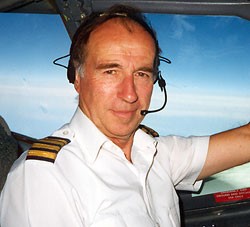
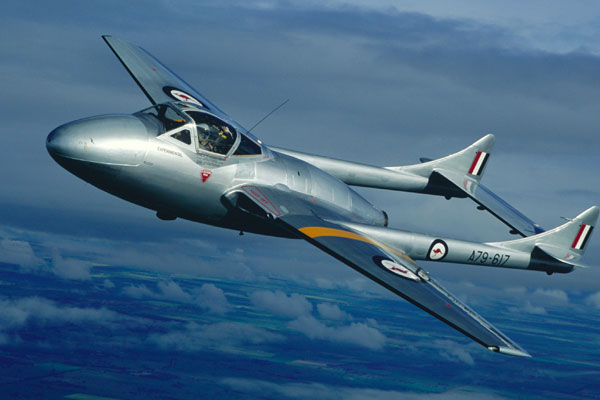 fighter pilots from them. They had all returned from a tour of 100
missions in Korea and were well qualified to pass their experiences on
to us. The Vampires we flew did not have ejection seats and it was
accepted that baling out at high speed should something go wrong was
impossible.
fighter pilots from them. They had all returned from a tour of 100
missions in Korea and were well qualified to pass their experiences on
to us. The Vampires we flew did not have ejection seats and it was
accepted that baling out at high speed should something go wrong was
impossible. 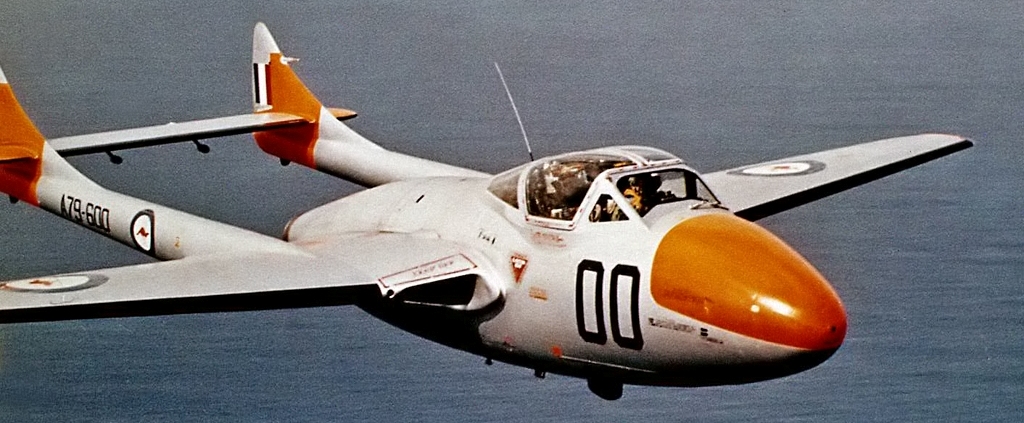 seat
version. Nevertheless, time was short and my instructor and I
squeezed into the cockpit of the dual Vampire and after airborne soon
caught up with our stooge.
seat
version. Nevertheless, time was short and my instructor and I
squeezed into the cockpit of the dual Vampire and after airborne soon
caught up with our stooge.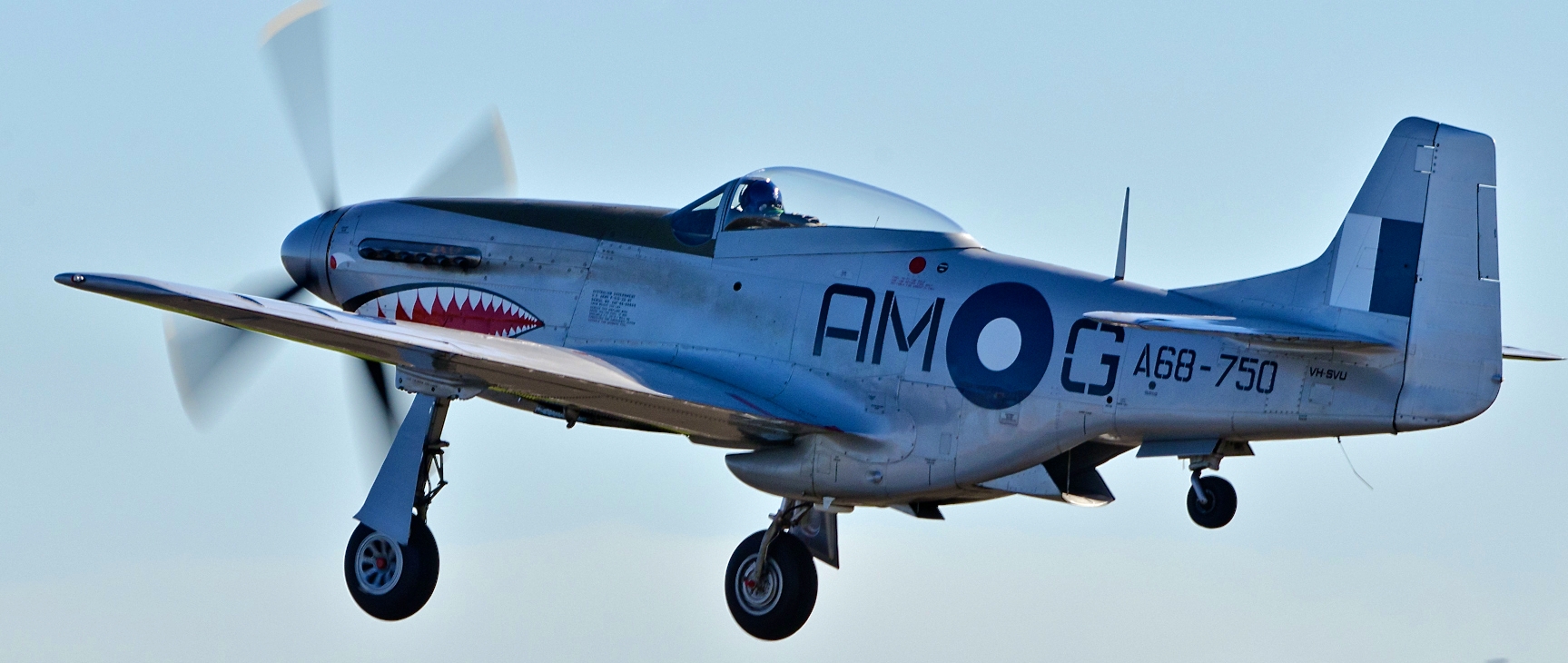 that briefing; many were fighter combat instructors as well as members
of my fighter course.
that briefing; many were fighter combat instructors as well as members
of my fighter course.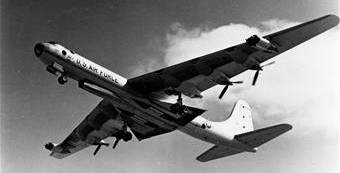
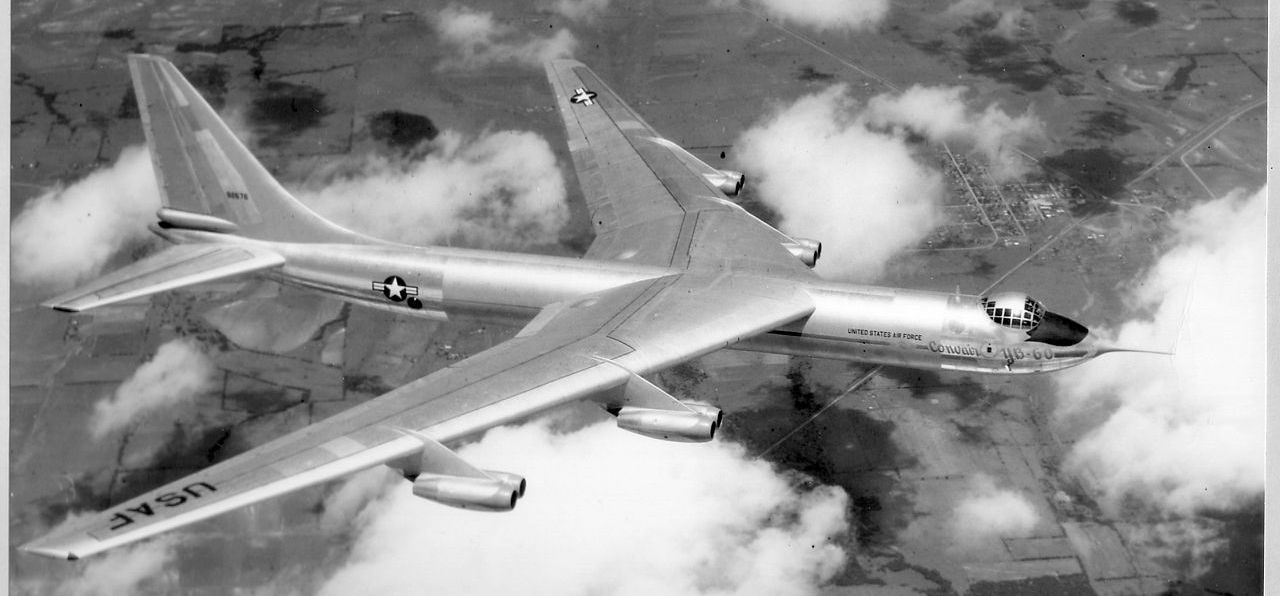 with
a needle-like instrument probe instead of the B-36's rounded nose; its
tail surfaces were swept to match the wings and a wedge-shaped insert
added at the wing root. The swept wings also used many B-36 parts.
with
a needle-like instrument probe instead of the B-36's rounded nose; its
tail surfaces were swept to match the wings and a wedge-shaped insert
added at the wing root. The swept wings also used many B-36 parts.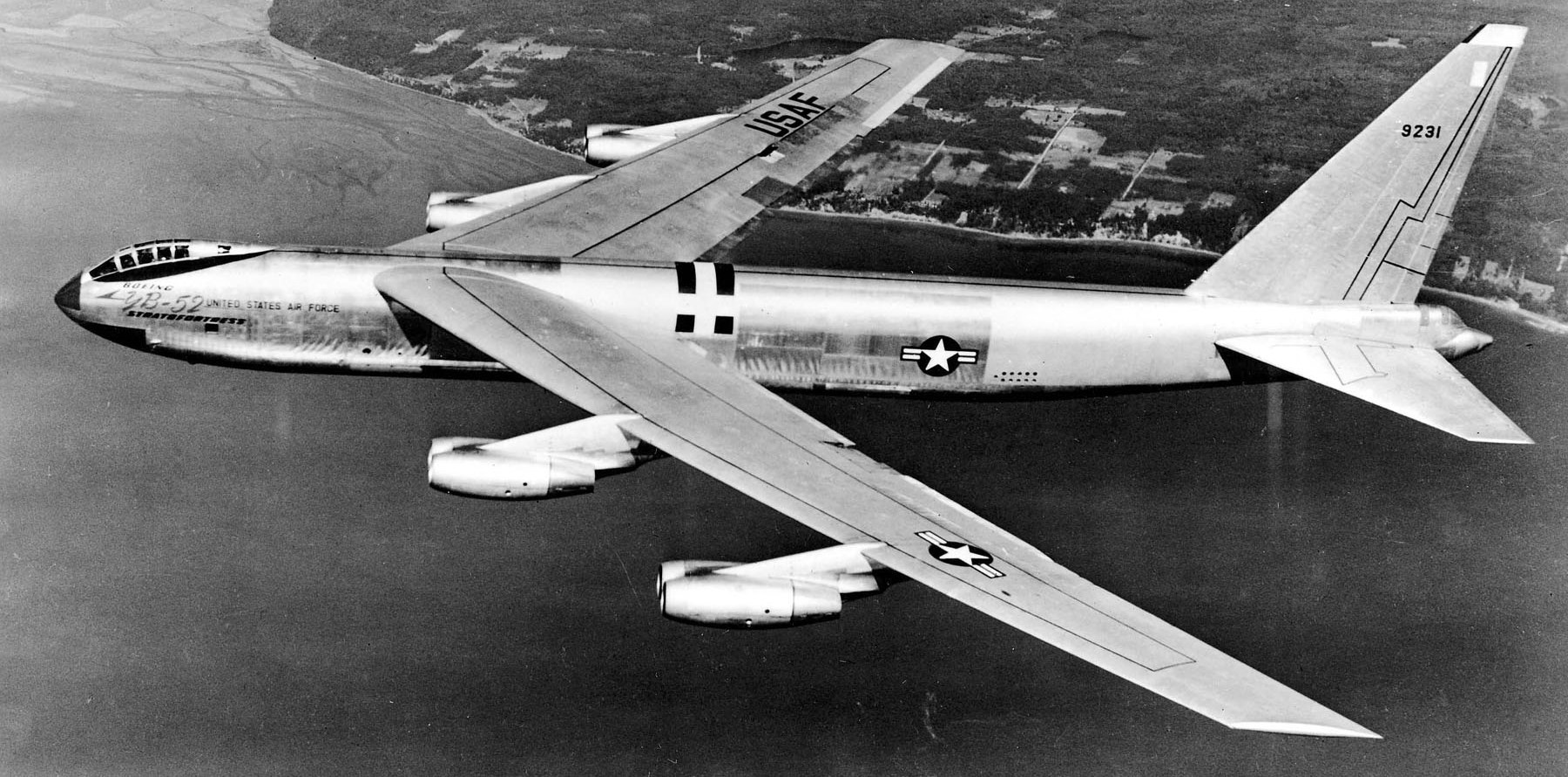
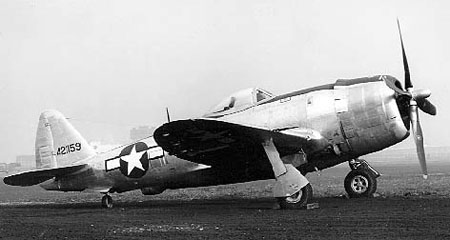
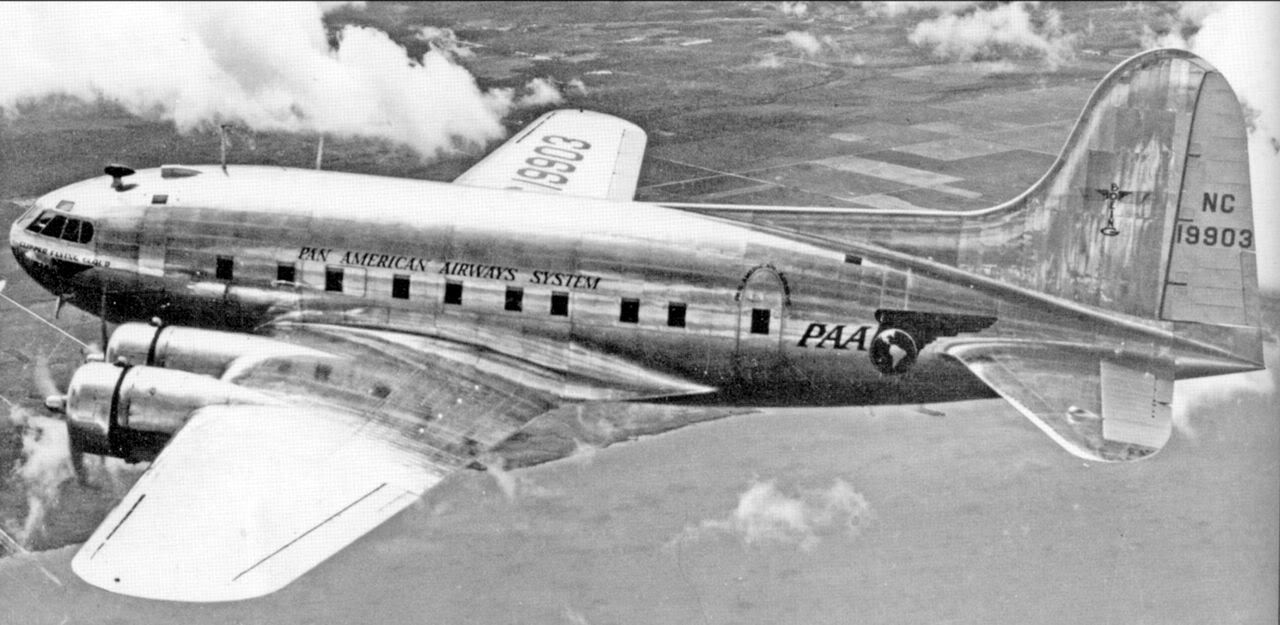
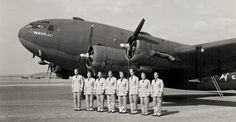 four-engined long-range commercial aircraft, including Pan American
Airways' 14 flying boats and TWA's five Boeing 307s, were pressed into
service. Additional fuel tanks were added to give them the extra range
required; once converted they were designated C-75 for military use.
Before World War II ended their production, ten commercial 307s had been
built. TWA flew domestic routes between New York and Los Angeles for 18
months until the Army purchased their Stratoliners for wartime use as
long-range, transatlantic transports for various VIPs or critical cargo.
TWA converted their 307s to military service in January 1942, and its
Intercontinental Division (ICD) then operated these C-75s under contract
to the Army's Air Transport Command (ATC) until July 1944. These were
the only U. S. built commercial aircraft able to cross the Atlantic with
a payload until the arrival of the Douglas C-54 Skymaster in November
1942.
four-engined long-range commercial aircraft, including Pan American
Airways' 14 flying boats and TWA's five Boeing 307s, were pressed into
service. Additional fuel tanks were added to give them the extra range
required; once converted they were designated C-75 for military use.
Before World War II ended their production, ten commercial 307s had been
built. TWA flew domestic routes between New York and Los Angeles for 18
months until the Army purchased their Stratoliners for wartime use as
long-range, transatlantic transports for various VIPs or critical cargo.
TWA converted their 307s to military service in January 1942, and its
Intercontinental Division (ICD) then operated these C-75s under contract
to the Army's Air Transport Command (ATC) until July 1944. These were
the only U. S. built commercial aircraft able to cross the Atlantic with
a payload until the arrival of the Douglas C-54 Skymaster in November
1942.